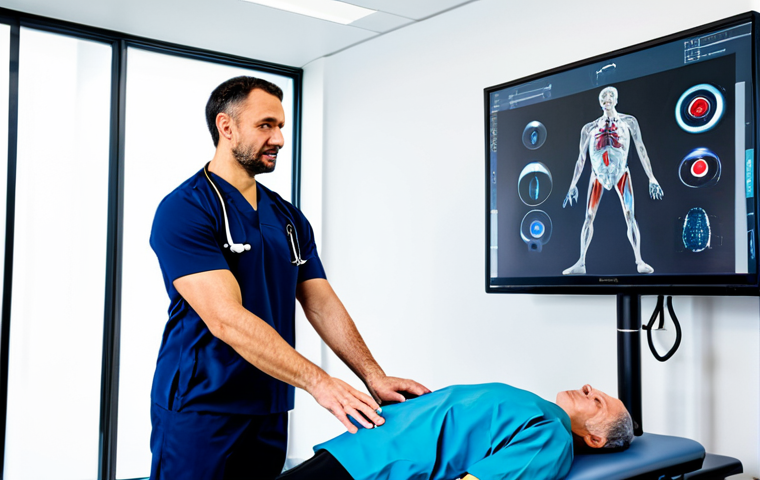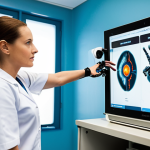Thinking about a career in physical therapy, or maybe you’re already in the trenches and curious about the academic journey? I remember standing at that very crossroads myself, grappling with the sheer weight of deciding which educational path would truly set me up for success.
It’s a common dilemma, especially with the evolving landscape of healthcare education. While the Doctor of Physical Therapy (DPT) is now the gold standard entry-level degree in many regions, there was a time when a Bachelor’s or Master’s degree was the primary gateway.
But what *really* sets them apart? Is it just about the letters after your name, or does it genuinely impact your scope of practice, your salary, or even your long-term career trajectory in a field increasingly integrating advanced diagnostics and personalized patient care?
It’s far more nuanced than you might think, influencing everything from your clinical autonomy to how you tackle the complex challenges of tomorrow’s patient needs, especially with the rise of telehealth and AI-driven rehabilitation.
Let’s unpack this in detail.
The Shifting Sands of Entry-Level Education in Physical Therapy

I remember grappling with this exact question, feeling a bit lost in a sea of acronyms and degree names. For anyone stepping into the world of physical therapy today, the Doctor of Physical Therapy (DPT) is unequivocally the gold standard entry-level degree across the United States and increasingly in other parts of the world.
But it wasn’t always this way, and understanding that evolution is key to appreciating why the DPT is what it is. Back when I was first looking into this, a Bachelor’s degree was a common starting point, followed by a Master’s degree for many.
This incremental shift, from a BPT to an MPT and then to the DPT, wasn’t just about adding more years to a degree; it reflected a fundamental change in the profession’s scope, its body of knowledge, and the level of clinical autonomy expected of practitioners.
It speaks volumes about how physical therapy has matured from a rehabilitative service to a primary care provider in musculoskeletal health, direct access to patients, and a greater emphasis on evidence-based practice and advanced diagnostic reasoning.
This transition has demanded a more rigorous, comprehensive education, moving beyond basic principles to embrace complex patient presentations, interdisciplinary collaboration, and research methodologies.
From Bachelor’s to Master’s: A Stepping Stone Era
Before the DPT became the norm, many seasoned physical therapists, myself included, started their careers with a Bachelor of Science in Physical Therapy (BSPT) or a Master of Physical Therapy (MPT).
The BSPT, typically a four-year undergraduate program, provided a foundational understanding of anatomy, physiology, kinesiology, and basic therapeutic interventions.
It was a solid start, equipping graduates to work under supervision and apply standard treatment protocols. However, as the profession grew in complexity and responsibility, particularly with the advent of direct access legislation allowing patients to see a PT without a physician’s referral, the need for a more advanced degree became apparent.
This led to the rise of the MPT, usually a two to three-year graduate program that built upon the undergraduate sciences, diving deeper into specialized areas like neurological rehabilitation, manual therapy techniques, and advanced exercise physiology.
For many, the MPT felt like a natural progression, offering enhanced clinical skills and a broader theoretical base, preparing practitioners for more independent practice and critical thinking.
It truly felt like we were gaining more confidence and competence with each additional layer of education.
The DPT Ascendancy: Why the “Doctorate” Matters
The move to the Doctor of Physical Therapy (DPT) as the entry-level degree wasn’t just an academic upgrade; it was a strategic shift to elevate the profession’s standing in the healthcare landscape.
This transition was driven by a push for physical therapists to be recognized as autonomous practitioners capable of independent judgment, diagnosis, and treatment planning, much like physicians, dentists, or chiropractors.
The DPT curriculum, typically a three-year post-baccalaureate program, is designed to provide an even deeper, more robust education. It significantly expands on advanced differential diagnosis, pharmacology relevant to physical therapy, advanced medical imaging interpretation, evidence-based practice methodologies, and a much greater emphasis on critical thinking and clinical reasoning.
From my perspective, having observed this transition firsthand, the DPT truly empowers therapists to take on more complex cases, function with greater independence, and contribute more comprehensively to a patient’s overall healthcare plan.
It’s not about becoming a medical doctor, but about operating at a higher level within our specific scope, ensuring patients receive the most thorough and effective care from a well-rounded expert.
The Breadth and Depth of Clinical Training
When you compare the educational pathways, one of the most striking differences, beyond the theoretical knowledge, lies in the sheer volume and diversity of clinical experiences embedded within each program.
I remember feeling like my own clinical rotations were formative, but knowing what DPT students go through now, it’s a whole different ballgame. The current DPT programs place an incredibly strong emphasis on extensive, varied clinical rotations, preparing graduates for an array of patient populations and practice settings.
This comprehensive approach ensures that new PTs are not just academically proficient but also clinically resilient and adaptable right from day one. It’s truly about bridging the gap between classroom learning and real-world application, which, let’s be honest, is where the rubber meets the road in patient care.
The Evolution of Hands-On Experience
In the earlier Bachelor’s and Master’s programs, clinical training was certainly a component, but often less intensive and diversified than what’s required today.
A BSPT might have included a few hundred hours of supervised clinical work, typically in a general outpatient setting or hospital. MPT programs expanded this, offering more hours and perhaps exposure to one or two specialized areas like neurological or orthopedic rehabilitation.
However, DPT programs mandate a significantly greater number of clinical hours, often exceeding 1,000 hours, across a wider range of settings. This typically includes acute care, inpatient rehabilitation, outpatient orthopedics, pediatrics, geriatrics, and sometimes even specialized areas like sports medicine or women’s health.
For students today, this means walking out with practical experience treating everything from complex multi-system trauma patients in an ICU to helping a child with developmental delays.
This immersive, multi-faceted exposure significantly enhances their diagnostic acumen, treatment planning skills, and overall confidence.
Problem-Solving and Direct Patient Management
The depth of clinical training in DPT programs also fosters a more robust approach to problem-solving and direct patient management. While earlier degrees taught foundational skills, the DPT curriculum pushes students to independently analyze complex cases, formulate differential diagnoses, and design comprehensive, evidence-based treatment plans with less direct supervision during their final clinical experiences.
This prepares them for direct access practice, where they are often the first point of contact for patients with musculoskeletal issues. I often reflect on how much more equipped DPT graduates are to handle the initial patient assessment and decision-making process, a skill that was often developed more gradually over years of practice for those of us with older degrees.
It’s truly about cultivating a proactive, critical thinking mindset from the outset of their careers.
Impact on Clinical Autonomy and Scope of Practice
One of the most significant arguments for the DPT degree is its direct impact on the physical therapist’s autonomy and the expansive scope of practice.
This isn’t just about feeling more independent; it’s about the legal and professional recognition that allows physical therapists to operate at the peak of their education and training.
I distinctly remember the early days when everything felt like it needed a physician’s sign-off, even for what seemed like basic interventions. The shift has been transformative, truly empowering the profession.
Expanded Decision-Making Authority
With the DPT, physical therapists in most states and regions now have direct access, meaning patients can seek PT services without a physician referral.
This fundamental shift requires a higher level of diagnostic capability and independent clinical judgment. DPT curricula are specifically designed to equip graduates with advanced differential diagnosis skills, enabling them to identify not only musculoskeletal conditions suitable for PT but also to recognize “red flags” that warrant referral to other healthcare professionals.
This expanded decision-making authority allows DPTs to initiate care promptly, reducing healthcare delays and potentially improving patient outcomes. It feels like a massive leap forward for both the profession and patient accessibility.
Specialization and Advanced Practice Roles
The DPT degree also serves as a stronger foundation for pursuing advanced specialization and taking on leadership roles within the profession. Whether it’s through residency and fellowship programs in areas like orthopedics, neurology, sports, or women’s health, or pursuing board certification as a clinical specialist (OCS, NCS, SCS, etc.), the DPT provides the necessary academic rigor.
This deeper dive into specific areas allows physical therapists to become true experts in their niche, pushing the boundaries of practice and research.
This level of specialization not only benefits the individual therapist’s career trajectory but also significantly enhances the quality of specialized care available to patients, fostering innovation in treatment approaches and rehabilitation science.
Career Trajectory and Financial Considerations
Let’s be honest, when you’re investing years of your life and a significant amount of money into an education, you want to know what the return will be.
From my vantage point, the DPT has undeniably opened up more doors and, typically, higher earning potential compared to its predecessors. It’s not just about the starting salary; it’s about the long-term growth and opportunities for leadership and entrepreneurship.
Earning Potential and Job Market Advantages
While a Bachelor’s or Master’s in PT could land you a job, the DPT generally commands a higher starting salary and greater earning potential throughout a career.
Employers often prefer DPT graduates due to their comprehensive training and readiness for independent practice, which can translate into better job offers and faster career advancement.
The U.S. Bureau of Labor Statistics, for example, consistently projects strong growth for physical therapy jobs, with DPTs being the preferred, if not required, qualification.
From what I’ve observed, it really does give you a leg up in a competitive market, signaling to employers that you’re fully equipped to handle modern demands.
| Feature | Bachelor of PT (BSPT) | Master of PT (MPT) | Doctor of Physical Therapy (DPT) |
|---|---|---|---|
| Typical Duration | 4 years (undergraduate) | 2-3 years (post-bachelor’s) | 3 years (post-bachelor’s) |
| Entry-Level Degree Status | Previous (pre-2002 U.S.) | Previous (2002-2015 U.S.) | Current Standard (U.S., most regions) |
| Depth of Curriculum | Foundational, basic interventions | Intermediate, some specialization | Advanced, comprehensive diagnostics, research |
| Clinical Hours (Approx.) | Few hundred | 500-800 | 1000+ |
| Autonomy/Direct Access | Limited, often required physician referral | Some, dependent on state laws | High, direct access common in many regions |
| Career Opportunities | General practice, supervised roles | Broader practice, some independent roles | Diverse roles, specialization, leadership, research |
Investment and Return on Education
Of course, a DPT degree also represents a significant financial investment, with tuition fees and living expenses accumulating over three years of graduate study.
However, for many, the long-term return on this investment through higher salaries, increased career satisfaction, and diverse professional opportunities outweighs the initial cost.
When I reflect on my own educational journey and compare it to the trajectory of DPT graduates, it’s clear that while the upfront cost might seem daunting, the doors it opens in terms of specialized roles, leadership, and even private practice ownership are substantial.
It’s about seeing it as a long-term investment in a highly rewarding and in-demand profession, where your expertise is not just valued but crucial.
Navigating Licensure and Professional Recognition
Beyond the academic journey, the practical step of obtaining licensure is paramount, and the type of degree you hold plays a direct role in this process.
It’s not just about getting through school; it’s about being legally recognized to practice. I remember the anxiety around licensure exams, and how crucial it was to understand the evolving requirements.
State and National Licensure Requirements
In the United States, licensure for physical therapists is regulated at the state level, but the Federation of State Boards of Physical Therapy (FSBPT) develops the National Physical Therapy Examination (NPTE).
For new graduates, possessing a DPT degree from an accredited program is almost universally a prerequisite for sitting for the NPTE. While existing practitioners with older degrees (BSPT or MPT) are “grandfathered in” and can continue to practice, new applicants must typically hold a DPT.
This standardization ensures a consistent level of competence and knowledge across the nation, which is incredibly important for patient safety and professional mobility.
It simplifies the process for recent graduates and ensures employers that a new hire meets the highest current educational standards.
Global Recognition and Mobility
For physical therapists considering international practice, the DPT degree often provides a more universally recognized credential. While each country has its own regulatory bodies and licensure requirements, a doctorate-level degree tends to be viewed more favorably and simplifies the credentialing process compared to a Bachelor’s or Master’s degree.
In many European and Asian countries, the equivalent of a DPT is becoming the standard. This global recognition is a huge benefit in an increasingly interconnected world, allowing practitioners to explore opportunities abroad or to welcome international patients with confidence in their own qualifications.
From my perspective, having a DPT simply opens up more possibilities for where you can live and work, making your skills transferable across borders.
The Future Landscape of Physical Therapy
Looking ahead, it’s clear that the physical therapy profession is dynamic, constantly evolving with advancements in technology, research, and healthcare policy.
The DPT degree, in my view, positions future practitioners not just to adapt to these changes but to lead them. This isn’t just about treating injuries; it’s about proactive health, wellness, and optimizing human movement in an ever-changing world.
Technology Integration and Telehealth
The rise of telehealth, wearable technologies, and AI-driven diagnostics is rapidly transforming how physical therapy is delivered. DPT programs are increasingly incorporating curricula that prepare students to leverage these technologies effectively, from conducting virtual consultations to analyzing data from movement sensors.
The emphasis on evidence-based practice within the DPT curriculum also means graduates are better equipped to critically evaluate new technologies and integrate those that truly benefit patient care.
I’ve seen firsthand how crucial it is to stay on top of these trends, and the DPT foundation provides that crucial analytical framework. It’s exciting to think about how these advancements will continue to enhance our ability to reach and help patients in new ways.
Population Health and Wellness Focus
Beyond individual patient care, physical therapists are playing an increasingly vital role in population health and wellness initiatives. This includes designing and implementing preventative programs, promoting physical activity, and addressing chronic disease management on a larger scale.
The comprehensive nature of the DPT education, with its strong emphasis on research, public health principles, and interdisciplinary collaboration, prepares graduates to contribute meaningfully to these broader health goals.
It’s about moving beyond just fixing problems after they occur to actively preventing them and promoting long-term well-being. This shift towards proactive care is where I see the profession making its biggest impact in the coming decades, and DPTs are truly at the forefront of this movement.
Closing Thoughts
As I look back on the evolution of physical therapy education, it’s truly remarkable to see how far the profession has come. The transition to the Doctor of Physical Therapy (DPT) degree isn’t just an academic formality; it’s a testament to our commitment to excellence, patient safety, and expanded professional autonomy. For anyone considering this incredibly rewarding field, embarking on the DPT journey means you’ll be entering a profession at its peak, fully equipped to make a profound difference in people’s lives with the highest level of expertise. It’s a challenging path, but one that promises immense personal and professional fulfillment.
Useful Information to Know
1. Accreditation Matters: Always ensure any DPT program you consider is accredited by the Commission on Accreditation in Physical Therapy Education (CAPTE). This is crucial for licensure and professional recognition in the United States.
2. Prerequisites are Key: Most DPT programs require a bachelor’s degree in a related field (like Kinesiology, Biology, or Exercise Science) and specific prerequisite courses in sciences such as anatomy, physiology, chemistry, and physics.
3. Consider Residencies & Fellowships: After earning your DPT, you can further specialize through post-graduate residency or fellowship programs in areas like orthopedics, neurology, or sports physical therapy, deepening your expertise.
4. Diverse Specializations: The DPT prepares you for a wide range of specializations. Beyond general practice, physical therapists work in pediatrics, geriatrics, wound care, women’s health, oncology, and even performing arts, among others.
5. Robust Job Market: The U.S. Bureau of Labor Statistics projects a much faster than average growth for physical therapist employment, indicating a strong and consistent demand for DPT graduates in the coming years.
Key Takeaways
The Doctor of Physical Therapy (DPT) is the undisputed entry-level degree for physical therapists in the U.S. and increasingly globally. This shift reflects the profession’s expanded scope, the need for advanced diagnostic and clinical reasoning skills, and the push for greater autonomy. DPT programs offer significantly more rigorous curricula and extensive clinical hours compared to older Bachelor’s or Master’s degrees, preparing graduates for independent practice and complex patient presentations. While representing a substantial investment, the DPT typically leads to higher earning potential, broader career opportunities, enhanced professional recognition, and ultimately, superior patient outcomes.
Frequently Asked Questions (FAQ) 📖
Q: Beyond the “DPT” letters, how does this degree truly expand your clinical autonomy and the day-to-day scope of practice compared to the older Bachelor’s or Master’s in physical therapy?
A: Oh, this is such a critical question, and it’s far more profound than just a title change. From my own experience, stepping out with a DPT felt like I was handed the keys to a far more sophisticated vehicle.
The biggest game-changer, hands down, is the concept of direct access in so many states now. With a DPT, I can often evaluate and treat patients without a physician referral, which was rarely the case with a Master’s or Bachelor’s degree.
This isn’t just a convenience; it speaks volumes about the trust and authority placed in DPTs. The DPT curriculum dives deep into differential diagnosis, pharmacology, and advanced imaging concepts – not that we’re ordering MRIs, but understanding them from a nuanced perspective is absolutely crucial for complex patient cases.
I remember one particular patient who presented with what seemed like a straightforward backache, but my DPT training screamed “red flag.” That deeper diagnostic reasoning, which was really hammered home in my program, allowed me to catch something far more serious, leading to a crucial referral.
It’s about having a broader, more integrated understanding of the human body and pathology, empowering you to make more autonomous, complex clinical decisions and really, truly advocate for your patient’s overall health, not just their physical therapy needs.
Q: Does the investment in a Doctor of Physical Therapy (DPT) degree genuinely translate into higher earning potential or open up significantly different career trajectories compared to someone with a Master’s or Bachelor’s degree in the field?
A: That’s the million-dollar question, isn’t it? And it’s one I wrestled with myself. From what I’ve seen, and certainly in my own journey, while the immediate starting salary jump right out of a DPT program versus, say, a Master’s might not be a seismic shift, the long-term trajectory and the breadth of opportunities absolutely are.
Think of it this way: the DPT is now the expected entry-level degree. So, it’s less about getting ahead and more about staying current and viable in the competitive landscape.
With a DPT, doors to specialization feel wider open – whether that’s becoming an orthopedic clinical specialist, diving into neurological rehab, sports, or even pediatrics.
I’ve also observed DPTs more readily ascending into leadership roles like clinic directors, regional managers, or even pursuing academic positions. The advanced coursework often includes business principles, research methodologies, and leadership skills that just weren’t as deeply integrated into older programs.
While a Master’s-prepared PT can be excellent, I’ve personally seen a difference in how employers view the DPT for roles that require more autonomy, research, or a path towards management.
It’s an investment, yes, but one that fortifies your professional standing and, ultimately, your earning power and career resilience over the span of your working life.
Q: With the rapid rise of telehealth and
A: I-driven rehabilitation, how does the DPT curriculum specifically prepare physical therapists for these evolving healthcare trends and what kind of unique challenges or opportunities do they present?
A3: This is where I think the DPT truly shines in its forward-thinking design. When I was going through my program, the seeds of these future trends were already being planted.
The DPT curriculum, unlike many older programs, places a significant emphasis on evidence-based practice, critical appraisal of research, and adaptability – skills that are absolutely crucial for navigating a rapidly changing landscape.
We didn’t just learn “how to treat”; we learned how to learn and how to critically evaluate new technologies. For telehealth, for instance, the DPT often includes specific training on remote assessment techniques, ethical considerations, and understanding the nuances of building rapport through a screen.
It’s not just about a video call; it’s about adapting your clinical eye to a two-dimensional space. As for AI, the DPT isn’t turning us into programmers, but it instills a foundational understanding of data analysis and how to ethically and effectively integrate AI tools into patient care – think AI-powered gait analysis, personalized exercise prescription tools, or predictive analytics for recovery.
The challenge is staying ahead, but the DPT mindset equips you with the confidence to embrace these tools as extensions of your clinical practice, rather than fearing them.
My DPT background made me feel prepared, not overwhelmed, when I started integrating virtual sessions and exploring AI-assisted biomechanics analysis for my athletes – it simply became another layer of sophisticated care I could provide.
📚 References
Wikipedia Encyclopedia
구글 검색 결과
구글 검색 결과
구글 검색 결과
구글 검색 결과
구글 검색 결과



